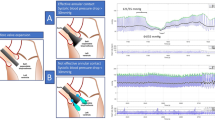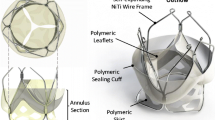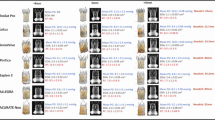Abstract
Pressure recovery downstream of the aortic valve constitutes an important factor affecting the calculation of pressure gradient (PG) across the valve and therefore the accuracy of the calculated aortic valve area. Some clinical studies hypothesized that stent and valve cusps design contribute to flow acceleration and Doppler-measured valve gradients across the balloon-expandable transcatheter aortic valve. This study aims at elucidating the physical mechanisms behind pressure recovery variations between Edwards SAPIEN 3 and Medtronic Evolut TAVs through the measurements of sensitive and precise axial pressure profiles. A 23 mm Edwards SAPIEN3 and a 26 mm Medtronic Evolut were deployed in a pulse duplicator. A Millar catheter was used to record 50 cycles of pressure data along the centerline of the valve chamber upstream and downstream of the valve. The peak PG obtained with SAPIEN at vena contracta (VC) is 18.83 ± 0.75 mmHg and after recovery, 9.56 ± 0.78 mmHg. For Evolut at VC, peak PG is 18.25 ± 0.63 mmHg and after recovery, 10.3 ± 0.57 mmHg. The differences in peak PG at VC and at the recovery were statistically significant (p < 0.001). With SAPIEN 3 at VC, the mean PG obtained is 10.11 ± 0.63 mmHg and after recovery 7.06 ± 0.46 mmHg. For Evolut, mean PG at VC is 10.45 ± 0.67 mmHg and after recovery 7.99 ± 0.61 mmHg. The differences between the mean PG between the two valves was not statistically significant at VC (p = 0.71) but significant post-recovery (p < 0.00001). While gradients at the VC are higher with the SAPIEN 3, the net gradient after pressure recovery is significantly lower compared to Evolut TAV. Efficiency of pressure recovery significantly depends on valve type due to stent interference with the recovering blood flow.







Similar content being viewed by others
Abbreviations
- PG:
-
Pressure gradient
- TAVR:
-
Transcatheter aortic valve replacement
- VC:
-
Vena contracta
References
Alston, M., et al. 600.19 Invasive versus Doppler-derived gradients after TAVR. JACC Cardiovasc Interv 12(4):S48, 2019.
Bach, D. S. Echo/Doppler evaluation of hemodynamics after aortic valve replacement: principles of interrogation and evaluation of high gradients. JACC Cardiovasc Imaging 3(3):296–304, 2010.
Bahlmann, E., et al. Impact of pressure recovery on echocardiographic assessment of asymptomatic aortic stenosis: a SEAS substudy. JACC Cardiovasc Imaging 3(6):555–562, 2010.
Bahlmann, E., et al. Prognostic value of energy loss index in asymptomatic aortic stenosis. Circulation 127(10):1149–1156, 2013.
Baumgartner, H., V. Falk, J. J. Bax, M. De Bonis, et al. ESC/EACTS Guidelines for the management of valvular heart disease: the task force for the management of valvular heart disease of the European Society of Cardiology (ESC) and the European Association for Cardio-Thoracic Surgery (EACTS). Eur Heart J 2017(38):2739–2791, 2017.
Chambers, J. Is pressure recovery an important cause of “Doppler aortic stenosis” with no gradient at cardiac catheterisation? Heart 76(5):381, 1996.
Garcia, D., et al. Discrepancies between catheter and Doppler estimates of valve effective orifice area can be predicted from the pressure recovery phenomenon: practical implications with regard to quantification of aortic stenosis severity. J Am Coll Cardiol 41(3):435–442, 2003.
Giersiepen, M., et al. Estimation of shear stress-related blood damage in heart valve prostheses-in vitro comparison of 25 aortic valves. Int J Artif Organs 13(5):300–306, 1990.
Hahn, R. T., et al. Comprehensive echocardiographic assessment of normal transcatheter valve function. JACC Cardiovasc Imaging 12(1):25–34, 2019.
Hatoum, H., and L. P. Dasi. Spatiotemporal complexity of the aortic sinus vortex as a function of leaflet calcification. Ann Biomed Eng 47(4):1116–1128, 2019.
Hatoum, H., F. Heim, and L. P. Dasi. Stented valve dynamic behavior induced by polyester fiber leaflet material in transcatheter aortic valve devices. J Mech Behav Biomed Mater 86:232–239, 2018.
Hatoum, H., B. L. Moore, and L. P. Dasi. On the significance of systolic flow waveform on aortic valve energy loss. Ann Biomed Eng 46(12):2102–2111, 2018.
Hatoum, H., et al. Modeling of the instantaneous transvalvular pressure gradient in aortic stenosis. Ann Biomed Eng 48:1748–1763, 2019.
Lancellotti, P., et al. Recommendations for the imaging assessment of prosthetic heart valves: a report from the European Association of Cardiovascular Imaging endorsed by the Chinese Society of Echocardiography, the Inter-American Society of Echocardiography, and the Brazilian Department of Cardiovascular Imaging. Eur Heart J Cardiovasc Imaging 17(6):589–590, 2016.
Mando, R., et al. Echo overestimates trans-aortic gradients immediately post TAVR: a pressure recovery phenomenon in a simultaneous CATH and ECHO study. J Am Coll Cardiol 73(9):1251, 2019.
Nygaard, H., et al. Two-dimensional color-mapping of turbulent shear stress distribution downstream of two aortic bioprosthetic valves in vitro. J Biomech 25(4):429–440, 1992.
Otto, C. M. Valvular aortic stenosis: disease severity and timing of intervention. J Am Coll Cardiol 47(11):2141–2151, 2006.
Schoephoerster, R. T., and K. B. Chandran. Velocity and turbulence measurements past mitrial valve prostheses in a model left ventricle. J Biomech 24(7):549–562, 1991.
Yang, S.K. and M.K. Chung. Turbulent flow through mixing spacer grids in rod bundles. In: 1995 National Heat Transfer Conference: Proceedings, Volume 14: Thermal Hydraulics of Advanced Nuclear Reactors, Containment Thermal-Hydraulics, HTD Volume 316, 1995.
Yudi, M. B., et al. Coronary angiography and percutaneous coronary intervention after transcatheter aortic valve replacement. J Am Coll Cardiol 71(12):1360–1378, 2018.
Zoghbi, W. A., et al. Guidelines for the evaluation of valvular regurgitation after percutaneous valve repair or replacement: a report from the American Society of Echocardiography developed in collaboration with the Society for Cardiovascular Angiography And Interventions, Japanese Society of Echocardiography, and Society for Cardiovascular Magnetic Resonance. J Am Soc Echocardiogr 32(4):431–475, 2019.
Disclosures
Dr. Dasi reports having patent applications filed on novel polymeric valves, vortex generators and superhydrophobic/omniphobic surfaces. Dr. Hahn is a consultant for Edwards Lifescience and Medtronic, and is Chief Scientific Officer for the Echocardiography Core Laboratory at the Cardiovascular Research Foundation for multiple industry-sponsored trials, for which she receives no direct industry compensation. No other conflicts were reported.
Funding
The research done was partly supported by National Institutes of Health (NIH) under Award Number R01HL119824 and the American Heart Association (AHA) under Award Number 19POST34380804.
Author information
Authors and Affiliations
Corresponding author
Additional information
Associate Editor Joel Stitzel oversaw the review of this article.
Publisher's Note
Springer Nature remains neutral with regard to jurisdictional claims in published maps and institutional affiliations.
Electronic supplementary material
Below is the link to the electronic supplementary material.
Video 1 Pressure gradient at peak flow variations during the cardiac cycle with SAPIEN 3 and Evolut at peak flow time point (AVI 6216 kb)
Rights and permissions
About this article
Cite this article
Hatoum, H., Hahn, R.T., Lilly, S. et al. Differences in Pressure Recovery Between Balloon Expandable and Self-expandable Transcatheter Aortic Valves. Ann Biomed Eng 48, 860–867 (2020). https://doi.org/10.1007/s10439-019-02425-8
Received:
Accepted:
Published:
Issue Date:
DOI: https://doi.org/10.1007/s10439-019-02425-8




